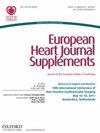Logistic回归与线性回归探讨健康素养对心力衰竭患者生活质量的重要性
IF 1.7
4区 医学
Q3 CARDIAC & CARDIOVASCULAR SYSTEMS
引用次数: 0
摘要
方法对亚历山大省两家医院的200例心力衰竭患者进行横断面研究。采用HLS-EU-Q16问卷评估HL, SF-12健康调查问卷评估生活质量,记录回顾和患者访谈收集所需数据。采用线性和逻辑回归模型探讨健康素养与生活质量的关系,并对两种模型进行比较。结果46.5%的HF患者有足够的HL, 53.5%的HF患者有不足的HL。SF-12问卷(PCS-12)生理维度得分较低,平均为34.16±10.43分;心理维度得分较好,平均为41.87±14.34分。对于PCS-12的线性回归,在调整个人和临床特征前后,HL均具有统计学意义,是HF患者PCS-12的独立预测因子。对于MCS-12,我们发现HL仅在调整前具有统计学意义,是MCS-12的独立预测因子。而在logistic回归中,考虑到PCS-12,分析显示HL在协变量调整前后均不是中位数分裂二分化PCS-12的统计学显著预测因子。对于MCS-12,我们发现HL仅在调整个人和临床特征之前具有统计学意义,并且是MCS-12中位数分裂二分的独立预测因子。PCS-12 logistic模型的预测正确率(70%)高于线性模型(53.5%)。同样,MCS-12 logistic模型的预测正确率(68.5%)高于线性模型(57.5%)。结论HL在线性回归模型中仅是SF-12的PCS-12的独立预测因子,而对MCS-12的独立预测因子无统计学意义,而在SF-12的两个维度的logistic模型中无统计学意义。然而,线性回归模型和逻辑回归模型这两种模型各有优缺点。本文章由计算机程序翻译,如有差异,请以英文原文为准。
Logistic regression vs. linear regression in exploring the importance of health literacy for the quality of life of patients with heart failure
Abstract Methods A cross sectional study was conducted among 200 heart failure patients selected from two hospitals in Alexandria governate. The HLS-EU-Q16 survey to assess HL, SF-12 health survey questionnaire to assess QoL, record review, and interviewing the patients were used to collect the required data. Linear and logistic regression models were used to explore the relation between health literacy and the QoL then comparing between the two models. Results Forty-six and half percent of HF patients had sufficient HL while 53.5% had insufficient HL. Patients showed low mean score of 34.16 ± 10.43 for the physical dimension of the SF-12 questionnaire (PCS-12), while the mental dimension (MCS-12) displayed good mean score of 41.87 ± 14.34. For the linear regression regarding PCS-12, HL was statistically significant and an independent predictor of PCS-12 in patients with HF, both before and after adjustment for the personal and clinical characteristics. Concerning MCS-12, we found that HL was statistically significant and an independent predictor of MCS-12 only before adjustment. While in logistic regression, considering PCS-12, analysis revealed that HL was not statistically significant predictor of the median-split dichotomized PCS-12 in both before and after adjustments for covariates. Regarding MCS-12, it was found that HL was statistically significant and an independent predictor of the median-split dichotomized MCS-12 only before adjustment for personal and clinical characteristics. The correct prediction percent in the logistic model of PCS-12 (70%) was higher than the linear model (53.5%). Similarly, the correct prediction percent in the logistic model of MCS-12 (68.5%) was higher than the linear model (57.5%). Conclusion It has been explained that HL is a statistically significant independent predictor of only the PCS-12 of SF-12 in the linear regression model but not for MCS-12, while it was not statistically significant predictor in the logistic models for the two dimensions of SF-12. However, each of the two models, linear regression model and logistic regression model, has its advantages and disadvantages.
求助全文
通过发布文献求助,成功后即可免费获取论文全文。
去求助
来源期刊

European Heart Journal Supplements
医学-心血管系统
CiteScore
3.00
自引率
0.00%
发文量
575
审稿时长
12 months
期刊介绍:
The European Heart Journal Supplements (EHJs) is a long standing member of the ESC Journal Family that serves as a publication medium for supplemental issues of the flagship European Heart Journal. Traditionally EHJs published a broad range of articles from symposia to special issues on specific topics of interest.
The Editor-in-Chief, Professor Roberto Ferrari, together with his team of eminent Associate Editors: Professor Francisco Fernández-Avilés, Professors Jeroen Bax, Michael Böhm, Frank Ruschitzka, and Thomas Lüscher from the European Heart Journal, has implemented a change of focus for the journal. This entirely refreshed version of the European Heart Journal Supplements now bears the subtitle the Heart of the Matter to give recognition to the focus the journal now has.
The EHJs – the Heart of the Matter intends to offer a dedicated, scientific space for the ESC, Institutions, National and Affiliate Societies, Associations, Working Groups and Councils to disseminate their important successes globally.
 求助内容:
求助内容: 应助结果提醒方式:
应助结果提醒方式:


